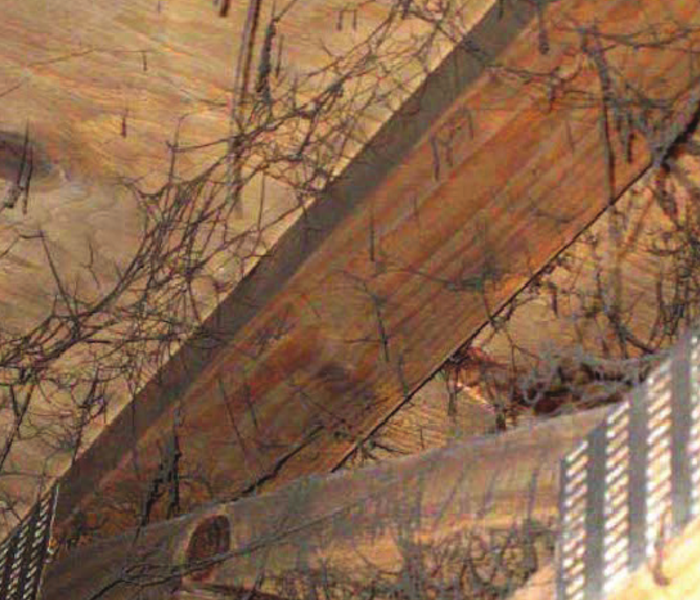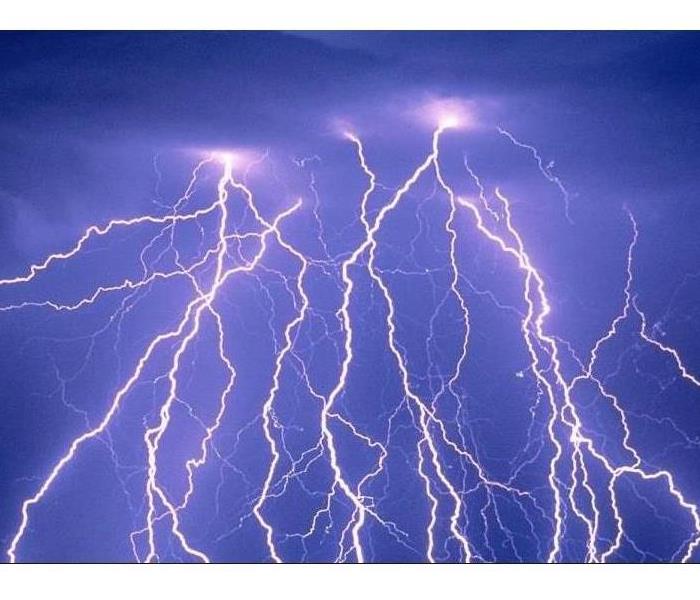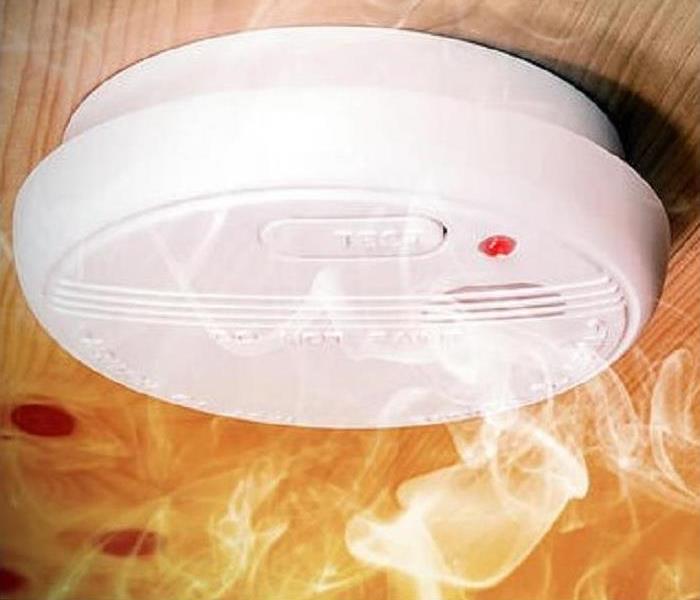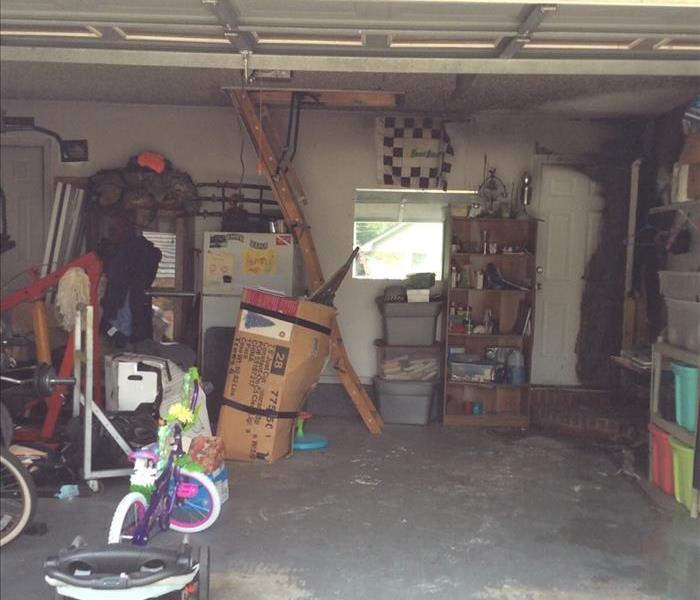Recent Fire Damage Posts
Navigating Fire Damage: What to Do After Your Home Sustains Fire Damage
2/10/2024 (Permalink)
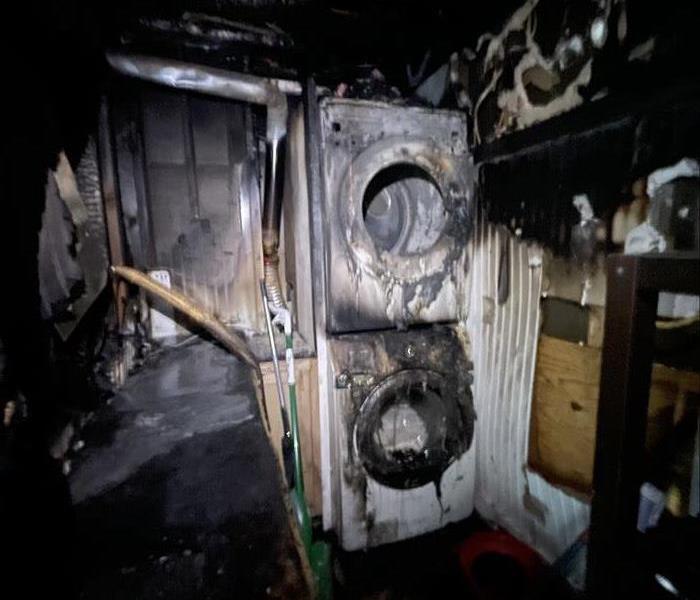 Completely burned out utility room.
Completely burned out utility room.
Experiencing a fire in your home can be a devastating and overwhelming situation. In the aftermath of a fire, it's crucial to take immediate action to ensure your safety and begin the restoration process. Here are the essential steps to take if your home in Santa Rosa County sustains fire damage:
Ensure Safety: Before re-entering your home, wait for authorities to confirm it is safe to do so. Be cautious of structural damage, electrical hazards, and lingering smoke or gas fumes. Wear appropriate personal protective equipment, such as gloves and a mask, to minimize exposure to soot and other contaminants.
Contact Your Insurance Company: Notify your insurance company as soon as possible to initiate the claims process. Provide detailed information about the extent of the damage and any valuable items that may have been affected. Your insurance provider can guide you through the necessary steps and coverage options for fire damage restoration.
Document the Damage: Take photographs or videos of the fire damage before beginning any cleanup or restoration efforts. Documenting the damage will serve as valuable evidence for your insurance claim and help restoration professionals assess the scope of work needed to restore your home.
Secure the Property: If your home has sustained structural damage or broken windows, take steps to secure the property to prevent further damage or unauthorized access. Board up windows, doors, and any openings to protect against weather elements and intruders.
Seek Professional Restoration Services: Fire damage restoration is a complex and specialized process that requires the expertise of trained professionals. Contact SERVPRO® of Santa Rosa County to assess the damage and develop a customized restoration plan. Our team of certified technicians will handle everything from debris removal and smoke odor removal to structural repairs and content restoration, restoring your home to its pre-fire condition efficiently and effectively.
Address Smoke Odor: Lingering smoke odor can permeate walls, furniture, and personal belongings, even after visible fire damage has been addressed. Our advanced deodorization techniques and equipment can effectively neutralize smoke odors and restore a fresh, clean scent to your home.
Consider Your Emotional Well-Being: Experiencing a fire can be traumatic, and it's essential to prioritize your emotional well-being during the recovery process. Lean on friends, family, and support networks for emotional support, and consider seeking professional counseling if needed.
Navigating the aftermath of a fire can be overwhelming, but with prompt action and the assistance of experienced professionals, you can begin the journey toward restoring your home and rebuilding your life. Trust SERVPRO of Santa Rosa County to be your partner in fire damage restoration, providing compassionate support and unparalleled expertise every step of the way.
Safeguarding Your Home: Avoiding Common Fire Hazards During the Holiday Season
12/4/2023 (Permalink)
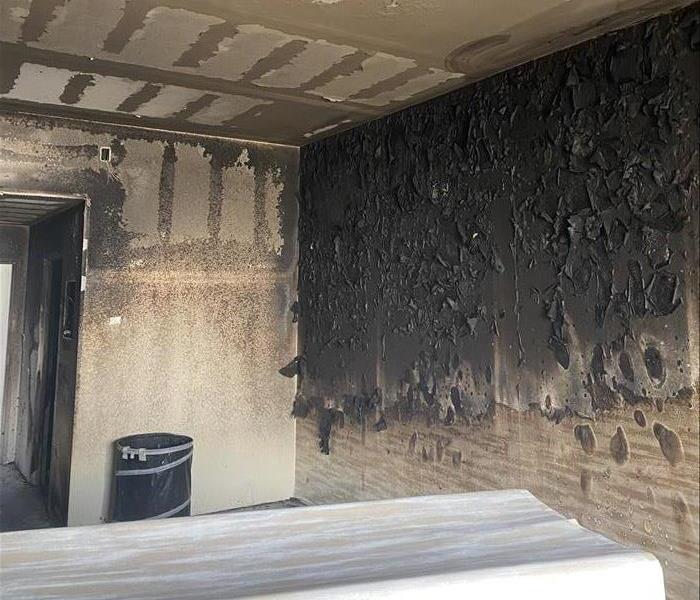 Interior fire damage
Interior fire damage
The holiday season is a time of joy and celebration, but it also brings an increased risk of home fires. From festive decorations to cooking feasts, there are several common fire hazards that homeowners should be aware of to keep their families and homes safe. In this blog post, SERVPRO discusses these potential hazards and provides tips on how to avoid them during the holiday season.
1. Decorative Lights and Candles:
String lights and candles can create a warm and cozy holiday atmosphere, but they are also common causes of fires. To avoid accidents:
- Inspect lights for frayed wires or damaged sockets before use.
- Use LED or flameless candles as safer alternatives to traditional candles.
- Keep lit candles away from flammable materials and never leave them unattended.
2. Overloaded Electrical Outlets:
With additional lights and decorations, it's easy to overload electrical outlets, which can lead to overheating and fires. To prevent this:
- Avoid daisy-chaining multiple extension cords.
- Use power strips with surge protectors to safely accommodate extra plugs.
- Unplug decorations when not in use or when you leave home.
3. Christmas Trees:
Real and artificial Christmas trees can pose fire risks if not handled correctly:
- Keep live trees well-watered to prevent them from drying out and becoming flammable.
- Position trees away from heat sources, like radiators or fireplaces.
- Consider using flame-retardant artificial trees.
4. Cooking Mishaps:
Holiday feasts can be a source of kitchen fires, especially when multiple dishes are being prepared simultaneously:
- Never leave cooking unattended.
- Keep flammable items, like kitchen towels and oven mitts, away from stovetops.
- Ensure smoke alarms are working properly.
5. Space Heaters:
As temperatures drop, space heaters become more common, but they should be used with caution:
- Keep space heaters at least three feet away from flammable materials.
- Turn off heaters when leaving a room or going to bed.
- Only use heaters in well-ventilated areas.
6. Fireplace Safety:
Using the fireplace for warmth and ambiance is a holiday tradition, but it can lead to accidents:
- Have your chimney cleaned and inspected before lighting the first fire of the season.
- Use a fireplace screen to prevent sparks from escaping.
- Never leave a fire unattended.
7. Smoking Materials:
If you or your guests smoke, be mindful of where you dispose of cigarette butts and matches:
- Provide designated smoking areas away from flammable materials.
- Use sturdy, deep ashtrays.
- Ensure cigarette butts are fully extinguished before disposal.
8. Fire Safety Equipment:
Make sure your home is equipped with functioning smoke detectors and fire extinguishers. Test your smoke detectors regularly and replace their batteries if needed. Check the expiration date on your fire extinguishers and replace them if they are no longer effective.
Conclusion:
By staying vigilant and taking precautions, you can enjoy a safe and joyful holiday season with your loved ones. Remember that fire safety is a collective effort, and everyone in your household should be aware of these common fire hazards and the steps to prevent them. If an unfortunate fire incident does occur, SERVPRO is here to assist you with fire damage restoration, ensuring your home is on its way to recovery.
SERVPRO of Santa Rosa: Your Trusted Partner for Short-Term Rental Property Fire Restoration
11/18/2023 (Permalink)
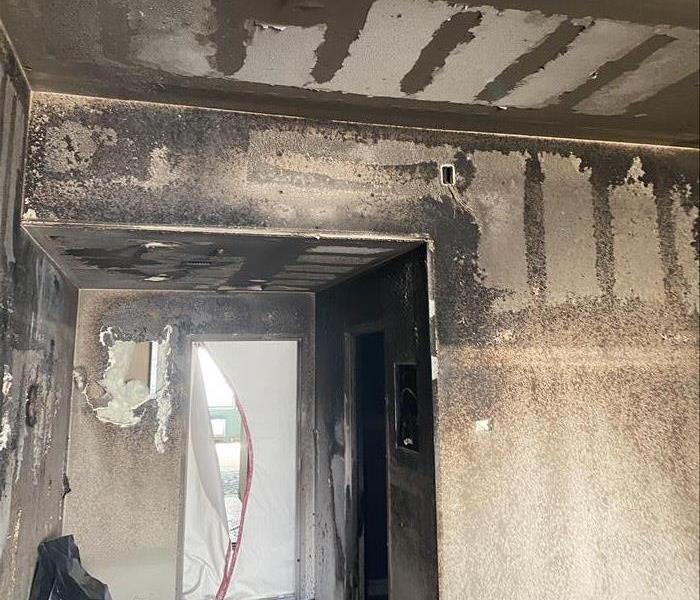 Interior fire damage
Interior fire damage
At SERVPRO of Santa Rosa County, we take immense pride in being your trusted partner for short-term rental property fire restoration in the Santa Rosa, FL area. We want to share why we are uniquely equipped and trained to handle any short-term rental property fire restoration job, no matter the size or complexity. Fires can be devastating, and in Santa Rosa, where short-term rental properties play a significant role in our community's tourism, having a reliable and experienced team to restore your rental property is of utmost importance.
1. Local Expertise, Community Commitment:
As a locally owned and operated SERVPRO® franchise, we understand the unique challenges that Santa Rosa faces when it comes to short-term rental property fire damage. We are deeply rooted in this community, and our commitment to its well-being is unwavering. However, what sets us apart is our access to SERVPRO's nationwide network. This network provides us with state-of-the-art equipment, industry-leading training, and invaluable resources. This combination of local expertise and global support allows us to handle any short-term rental property fire restoration job effectively.
2. Rapid Response, Minimized Disruption:
Fires in short-term rental properties can result in significant disruption to guests' plans and property owners' livelihoods. That's why our 24/7 emergency response ensures that we are always ready to mobilize in Santa Rosa. A swift reaction can significantly reduce the extent of damage and help you get back to serving guests sooner. We know that in Santa Rosa, where short-term rentals are a cornerstone of our tourism industry, time is of the essence.
3. Skilled Technicians, Personalized Solutions:
Our certified technicians are the heart of our operation. They bring a wealth of knowledge and experience to every short-term rental property fire restoration job in Santa Rosa. Whether it's a beachfront condo or a cozy vacation home, our team tailors a unique restoration plan to address the specific needs of your rental property. We leave no stone unturned in our mission to bring your rental property back to its pre-fire condition.
4. Comprehensive Cleanup and Restoration:
Short-term rental property fire damage is multifaceted, involving not only burnt materials but also soot, smoke residues, water damage, and structural issues. In Santa Rosa, we understand the complex nature of fire damage in rental properties. That's why we're equipped to handle it all. Our advanced cleaning techniques, industrial-grade equipment, and meticulous attention to detail ensure that every surface and element of your rental property is restored to its pre-fire condition.
5. Odor Elimination:
Lingering smoke odors can be a constant challenge for short-term rental properties in Santa Rosa. Our technicians are experts in smoke and odor removal. We employ specialized equipment and techniques to eliminate odors, ensuring that your rental property smells fresh and inviting for your guests.
6. Structural Restoration:
We recognize the importance of restoring the structural integrity of your rental property in Santa Rosa. Whether it involves rebuilding walls, replacing damaged flooring, or repairing roofs, we have the resources and expertise to handle any structural restoration task.
Success Stories in Santa Rosa:
Our journey in Santa Rosa has been marked by countless success stories in short-term rental property fire restoration. From helping property owners maintain their livelihoods to ensuring guests have a memorable experience, our commitment to the Santa Rosa community shines through. You can explore some of these inspiring stories on our website, where we share examples of how we've made a positive impact in the Santa Rosa area.
In Santa Rosa, when short-term rental property fire damage occurs, SERVPRO of Santa Rosa County is the name you can trust for comprehensive short-term rental property fire restoration services. From immediate response to meticulous cleanup and structural restoration, we have the expertise, resources, and dedication needed to handle any short-term rental property project, large or small.
If your short-term rental property in Santa Rosa experiences a fire, please reach out to SERVPRO of Santa Rosa County. We are here to provide the support, expertise, and unwavering commitment needed to restore your rental property to its pre-fire condition. Your guests' experience and your property's reputation are our top priorities.
SERVPRO Fire Damage Restoration Process in Santa Rosa County
8/24/2023 (Permalink)
 SERVPRO team was called out to assess a large structure fire in Santa Rosa County
SERVPRO team was called out to assess a large structure fire in Santa Rosa County
The time it takes for our SERVPRO technicians to complete fire damage restoration can vary depending on several factors such as the extent of the damage, size of the property, and the level of restoration required. In general, the process can take anywhere from a few days to several weeks.
The initial assessment and planning phase, which includes determining the scope of the damage and creating a restoration plan, can take a couple of days. The next step involves mitigating further damage by boarding up windows, tarping roofs, and drying out the property, which can take a few days or longer depending on the severity of the fire and the level of water or smoke damage.
The actual restoration process, including cleaning, repairing, and rebuilding damaged areas, can take anywhere from a few days to weeks, depending on the complexity of the project. This can involve removing and disposing of damaged materials, cleaning and deodorizing the property, repairing structural damage, and replacing flooring, walls, and other components.
It's important to note that every fire restoration project is unique, and the timeline can be influenced by factors such as the availability of materials, insurance processes, and the level of cooperation from the property owner. Santa Rosa SERVPRO professionals work efficiently to complete the restoration as quickly as possible while ensuring the highest quality workmanship.
They Are Not Spider Webs
2/25/2022 (Permalink)
When I first started out in the restoration industry, I thought that fires were the most interesting part of my job. From the burn patterns, figuring out the point of origin, to accelerants, arson investigations there were so many variables, each fire, and the way it burned was vastly different. I learned very quickly that the way you clean-up after a fire also varies from one fire to another. Over my 27-year career with SERVPRO I have learned so much.
When I went into these burned homes, I always wondered why the homes and commercial buildings we were cleaning up had such spider issues. Little did I know that in certain conditions called wet smoke, involving low heat, or smoldering type environments was what was causing these webs
Smoke webs are long chains of ionized smoke particles that assemble. Smoke-webs do not require pre-existing dust webs for support. Smoke webs are typically sticky and pungent and will smudge easily and show up areas where there is limited air flow, typically corners and edges of ceilings, in curtain folds, cabinets etc. In short, it is when plastics burn, the smoke carries a stronger charge than when wood, cotton, or paper burns. Depending on what exactly the webs are made of, they can be difficult to clean.
SERVPRO OF SANTA ROSA COUNTY is just a phone call away 24/7/365.
850-939-4700
What To Do When Your Home Gets Struck By Lightning
2/24/2022 (Permalink)
Being that I have spent 27 years with SERVPRO one of the craziest phenomenon’s that I do not think that people understand is the damage that a lightning bolt can do by either striking your home or the ground around your home. In my career I have been out to several homes that did not even get hit with an actual strike, the ground next to there home was hit, yet there home still ended up on fire.
It is storming outside tons of thunder and lightning, then the lightning strikes your house directly, do you know what to do? I suggest calling the fire department immediately. Lightning striking your home can cause a fire in the attic or walls of your home. Just because you do not see flames after a lightning strike does not mean you are out of the woods; enclosed space fires are not visible in their beginning stages.
Cloud-to-ground lightning bolt's main objective is to find a path of least resistance from the clouds to the ground. Gas lines, water pipes, electrical lines, phone lines, cable/internet lines, metal window frames, gutters, downspouts, anything that is conductive in your house is ‘fair game’ for lightning to follow, although it does not need conductive objects to reach the ground. Lightning can move its way through miles of air, so conductive objects in a house are not a necessity they are just a mere 'convenience' that it will use when available.
When lightning passes through a house it will often 'branch' (just like it does in the sky) and utilize more than one path to ground at a time. Lightning can also side flash, meaning it can also jump through the air from one conductive path to another. Let me give you an example, lightning’s path first may connect to your electric lines in the attic of your home, then possibly jump to better-grounded water pipes on the first or second floor. Remember you read earlier it is always trying to find that path of least resistance.
The current that lightning produces is significant to say the least. The damage lightning could cause to a home is substantial, but because the risk of your home getting struck by lightning is so low, very few homes have any sort of protection installed. It can also be very costly to have this protection system professional installed.
Below are three main hazards that can occur when a home gets struck:
- Fire danger: Most building materials are flammable and unfortunately can easily ignite anywhere that channel passes through them. The attic or the roof of your home are the most common areas for a fire to ignite relating to a lightning strike, as the lightning channel must pass through some of the structural material in the roof before it can reach a more conductive path such as wiring or pipes. When lightning current travels through wires, it will commonly burn them up - presenting a fire ignition hazard anywhere along the affected circuits.
- Power surge damage: If lightning chooses any of the home's electrical wiring as its primary or secondary path, the explosive surge can damage even non-electronic appliances that are connected. Even if most of the lightning current takes other paths to ground, the home's electrical system will experience enough of a surge to cause potentially significant damage to anything connected to it.
- Shock wave damage: Another major source of damage from lightning is produced from the explosive shock wave. The shock waves that lightning create is what produces the thunder that we hear, and at close range, these waves can be destructive. Lightning can easily fracture concrete, brick, cinderblock, and stone. Brick and stone chimneys are commonly damaged severely by lightning. Lightning's shock waves can blow out plaster walls, shatter glass, create trenches in soil and crack foundations. Shrapnel is a common secondary damage effect, with objects sometimes found embedded in walls!
What about a structure that has no wiring or pipes? It is rare for a house to be devoid of electrically conductive paths to ground, but they do exist - such as camping/fishing cabins. In that case, all bets are off on how the lightning will choose to reach the ground. Again, the lightning has just jumped across miles of non-conductive air, so the lack of wires or pipes will not stop it from passing through a completely non-conductive structure. Such a structure does not provide a person with good lightning protection - so if you are caught in one during a storm, consider moving into a hard-topped automobile which provides a much better degree of safety.
What can you do to stay safe from lightning while inside of your house?
Since we know the common paths, lightning can follow in a house (wiring and pipes), the best thing to do is stay away from those paths as best as possible during a storm. Direct contact with them should be avoided. This includes taking a shower or bath, washing hands, doing dishes, typing on a computer, playing video games, and using a wired phone, tool, or appliance. Metal-framed windows should be avoided. Wireless devices are safe to use (cell phones, cordless phones, remotes, etc.).
Direct skin contact with earth ground should also be avoided, as lightning current can travel through soil and across wet/damp concrete. Wear shoes if walking in a basement, garage, or patio.
What to do if lightning strikes your house
If your home is hit directly by lightning, your immediate concern should be for any fires that may have been ignited. Call the fire department! Again, the most common place for lightning-caused fires in a home is in the attic, but they can start anywhere the lightning has traveled. Some fires inside the walls and attic may not be immediately apparent and not easily accessible. You should also watch for falling debris from damaged chimneys, shingles, or walls.
You should also strongly consider contacting an electrician to have your home's electrical system inspected for any damage that might present a future fire hazard.
Can you get struck by lightning inside of a house?
While it is rare, yes, it is possible to receive a lightning injury inside a house. Burns and electric shock injuries can occur when someone is in direct contact with one of lightning's chosen paths to ground. The most common indoor lightning injuries involve a person talking on a corded phone or resting on/looking out of a metal-framed window. "Side flashes" (discussed above) that jump across rooms can also cause injuries but are exceedingly rare. Indirect shrapnel-related injuries from building materials have also been documented.
How to protect sensitive electronics from a strike
It is impossible to provide 100% protection to sensitive electronics from a direct lightning strike. The best thing to do is to unplug any high-value item you wish to protect during storms, as surge protectors and UPS units cannot provide direct-strike protection. Some could argue that the risk of a direct strike to any given house is too low to justify unplugging everything for every storm that passes overhead. It is wise to make sure your homeowner's or renter's insurance covers lightning damage. Your insured expensive electronics can be replaced. However, consider irreplaceable such as the data saved on your computer (photos, videos, work files, etc.). You can mitigate that risk by performing frequent offsite backups and/or storing data on an external hard drive that you can unplug when needed.
Should I have a lightning protection system installed?
A professionally installed lightning protection system can reduce or eliminate the fire and injury hazards if your house happens to be struck directly. You will want to assess the risk of a strike and weigh the costs versus benefits. Insurance may be a more cost-effective option, especially if you live in an area of average to below-average thunderstorm frequency. If you are in a zone if frequent lightning activity (such as Florida and the Gulf Coast regions of the USA), a protection system may offer more of a benefit.
SERVPRO of Santa Rosa County CAN HELP YOU WITH ALL YOUR CLEANING AND RESTORATION NEEDS!! CALL TODAY 850-939-4700
Protecting Yourself & Your Home
2/11/2022 (Permalink)
Here are eight tips you should know, plus resources to consult to learn more about protecting yourself and your home.
1. Maintain smoke alarms
- Smoke alarms should be installed in every bedroom, outside each sleeping area and on every level of the home.
- For better protection, smoke alarms should be interconnected so that if one sounds, they signal alerts throughout the home.
- Dust or vacuum your smoke alarms at least once a year when the battery is replaced. Replace the alarm itself every 10 years.
- If you are deaf or hard of hearing, install a smoke alarm that uses a flashing light or vibration to signal smoke.
2. Use caution with open flames
- Only burn candles when you are in the room, and use sturdy candleholders.
- Smoke outdoors only, and use deep, sturdy ashtrays. Make sure butts are cool before throwing them out.
- Avoid any open flame where medical oxygen is being used.
3. Cook safely
- Turn pot handles toward the back of the stove to prevent them from being knocked off.
- Stay in the kitchen when cooking on the stove or broiling.
- Keep a pot lid nearby while cooking. If a fire starts in a pan, you can slide the lid over and turn off the burner.
4. Heat your home safely
- Keep anything that can burn at least three feet from radiators, space heaters, fireplaces, woodstoves and furnaces.
- Use a space heater with an automatic shutoff in case it tips over or overheats.
- Turn off and unplug heaters when you leave your home or go to bed.
- Make sure chimneys are cleaned professionally every year.
5. Plan your escape route
- Know and practice two ways out of every room in your home.
- Clear clutter that might block your escape route, and make sure all doors and windows open with ease.
- Practice a fire escape drill at home at least twice a year.
- If you use a wheelchair or envision having a problem escaping a fire, plan ahead and let your fire department and neighbors know.
6. Practice electrical safety
- Have a licensed electrician check your electrical system if you frequently have blown fuses or tripped circuit breakers.
- Replace outlets if plugs don't fit snugly.
- Don't overload electrical circuits, and avoid using extension cords. Have an electrician install additional outlets if needed.
- Use light bulbs that match the recommended wattage on the light fixture.
- Keep bathroom fans clean of lint and dust, which can cause the motor to overheat and ignite.
7. Sign up for emergency alerts
- Sign up for alerts to receive calls or texts about impending storms or wildfires. Lightning can cause house fires.
- In the event of a disaster, heed evacuation orders and advice of officials.
8. Protect yourself in case of fire
- Stay calm, get out fast and stay outside the home.
- Feel the doorknob and cracks around a door before opening. If you feel heat, don't open it. Closed doors prevent the spread of fire.
- If you must escape through smoke, get low and go under the smoke to your exit.
- If you can't get out, call 911. Stay where you are and signal for help with a flashlight or brightly colored object through a window.
KEEP CALM AND CALL SERVPRO OF SANTA ROSA COUNTY 850-939-4700
Source: U.S. Fire Administration
Did You Know
2/11/2022 (Permalink)
Three out of five people who were injured during cooking fires were injured while trying to fight the fire themselves. Ranges or cook-tops are the most common equipment involved in home cooking fires. These account for 58 percent of fires. Ovens account for 16 percent. Microwave ovens are more dangerous than most folks think. They are one of the leading home products associated with scald burn injuries, accounting for 44 percent of the microwave injuries seen in emergency rooms in 2011. In the kitchen, it usually is not fires that burn young kids. More often, it is contact with a hot stove or pans or a scald from hot cooking liquids or steam. In fact, children under age 5 accounted for 55 percent of tableware scalds, 42 percent of contact burns from ranges or ovens, and 34 percent of microwave scalds in 2011.
- Cook only when you are alert -- not when you are exhausted, not when you have been drinking.
- Keep an eye on what you fry. If you must step away from the stove, turn it off.
- Keep things that can catch fire -- such as dish towels, potholders, and paper towels -- away from the stove. And avoid cooking in your bathrobe -- the loose sleeves can catch fire easily.
- Keep hot things away from the edges of tables and counters.
- Open microwaved food slowly and keep the food away from your face.
- Have a "kid-free" zone of at least three feet around the stove and anything hot -- and never hold your child while you are cooking or carrying something hot.
- Teach kids to stay away from the stove and hot foods.
- Keep pets off cooking surfaces.
- Install smoke alarms in the kitchen, outside each sleeping area, inside each bedroom, and on every level of your home (including the basement).
If you have a fire, just get outside, stay outside, and call the fire department.
If you are in need of fire remediation services, do not delay call SERVPRO OF SANTA ROSA 850-939-4700
Smoke Detection Systems
2/10/2022 (Permalink)
FIRE SAFETY
Most homeowners do not know that there are two types of smoke detectors on the market: ionization smoke detectors and photoelectric smoke detectors.
Ionization Smoke Detectors
This type of smoke detector uses ionized particles to detect the presence of smoke. Each ionization smoke detector holds a tiny amount of radioactive material, which is placed between two electrically charged plates. The reaction between these components causes the ionization of air. This in turn creates a current between the two plates.
When smoke gets into the detector, the current is disrupted, and the alarm is triggered. Ionization smoke detectors are known to work better with flaming fires—these are fires with aggressive, open flames. Their effectiveness with other types of fires, such as smoldering fires, is not as great. That is why we have another type of smoke detector.
Photoelectric Smoke Detectors
The second most popular type of smoke detectors are photoelectric detectors. Unlike ionization detectors, these detectors use a light source and a light sensor to detect smoke. The second most popular type of smoke detectors are photoelectric detectors. Unlike ionization detectors, these detectors use a light source and a light sensor to detect smoke.
Once the smoke enters the detection chamber, the smoke particles block the light beam and partially reflect light onto the sensors. This in turn trips the alarm. Since many smoldering fires fill the room with dangerous fumes and smoke way before progressing to the open-flame stage, these types of detectors tend to be better at early detection.
Different Power Supply Options
Now that we have covered the main types of smoke detectors, we need to touch upon different ways of supplying power to the detectors. There are two options, both of which work, but one of option is definitely a safer and more reliable choice.
Battery-Powered Detectors
Most detectors out there are powered by batteries. Since smoke detectors in general do not use a lot of power, many of these battery-powered models require very little maintenance on a yearly basis. However, every battery has a limit, and you do not want to find yourself in a fire with a dead smoke detector. There is nothing inherently wrong with battery-powered smoke detectors, but you must be vigilant about replacing spent batteries.
Hard-Wired Smoke Detectors
The alternative to battery-powered smoke detectors are hard-wired detectors. As their name implies, these detectors are wired straight into your home's electrical system. This method of supplying power to the entire network of smoke detectors is much more dependable and requires less maintenance.
Best of all, while these detectors still require batteries, batteries are not the primary power source. Rather, batteries function as the emergency power source to ensure you are still protected in the event of a power outage.
In Massachusetts, homes built between 1975 and 1998 must have hard-wired interconnected smoke detectors outside the bedrooms and one detector per floor.
How to Make the Most of Your Smoke Detectors
Smoke detectors, no matter the type, are your first line of defense against fires. Despite that, many homeowners tend to neglect them. Just by regularly replacing the batteries in your smoke detectors, you are reducing your chances of becoming a victim of a house fire.
Fire Damage and its Effects.
9/1/2021 (Permalink)
A fire can lead to serious and significant property damage and any number of problems that will negatively impact your quality of life and cost you a lot of money until you get them repaired. Many people don’t realize the full extent or nature of fire damage or a large number of different services offered by SERVPRO of Santa Rosa County. Fire damage can ruin walls, cabinets, counter tops and much more leaving them looking dilapidated and not fit to live in.
When it comes to repairing the obvious and immediate damage to your property, SERVPRO of Santa Rosa County will prioritize damage that could lead to further damage. A good example of this might be a burned stair case that is in danger of collapsing. Likewise, if you have a hole burned in your roof or in your wall then this might risk wind and rain blowing into your property and could even leave you vulnerable to trespassers and thieves. Again, this will be a very early issue that SERVPRO of Santa Rosa County will look at.
What to do and not do after a fire.
9/1/2021 (Permalink)
After any fire damage situation, your primary focus should be safety first:
- Is it safe to stay in the house?
- Electrical and "slip and fall" hazards are some of the most prevalent concerns.
- Only do activities that are safe for you to perform.
- Wet materials can be VERY heavy. Be careful!
Have Smoke or Fire Damage? Call (850) 939-4700
What To Do After A Fire
- Limit movement in the home to prevent soot particles from being embedded into upholstery and carpets.
- Keep hands clean so as not to further soil upholstery, walls and woodwork.
- Place clean towels or old linens on rugs, upholstery and carpet traffic areas.
- If electricity is off, empty freezer and refrigerator and prop doors open.
- Clean and protect chrome with light coating of petroleum jelly or oil.
- Wash houseplants on both sides of leaves.
- Change HVAC filter.
- Tape double layers of cheesecloth over air registers.
What NOT To Do After A Fire
- Don't attempt to wash any walls or painted surfaces or shampoo carpet or upholstery without contacting us.
- Don't attempt to clean any electrical appliances that may have been close to fire, heat or water without consulting an authorized repair service.
- Don't use any canned or packaged food or beverages that may have been stored near the fire, heat or water.
- Don't turn on ceiling fixtures if ceiling is wet. The wiring may be damaged.
- Don't send garments to an ordinary dry cleaner. Improper cleaning may set smoke odor.
Have Smoke or Fire Damage? Call 850-939-4700
2/20/2021 (Permalink)
SERVPRO of Santa Rosa County can help businesses across the county recover from any fire. Our certified technicians strive to arrive within a few hours of your call and are prepared to begin fire and smoke damage mitigation with our fully equipped company vehicles. We will introduce ourselves to you, walk through the building, explain the extent of damage and give recommendations of steps needed for thorough repair of fire and smoke damage. SERVPRO of Santa Rosa County documents everything, taking before and after pictures so you can rest assured that everything possible was done, and we will answer any questions you have.
Please do not hesitate to give us a call with any emergency 7 days a week, 24 hours a day. We make it look "LIKE IT NEVER HAPPENED!"
Kitchen Fires and Lingering Odor?
1/11/2021 (Permalink)
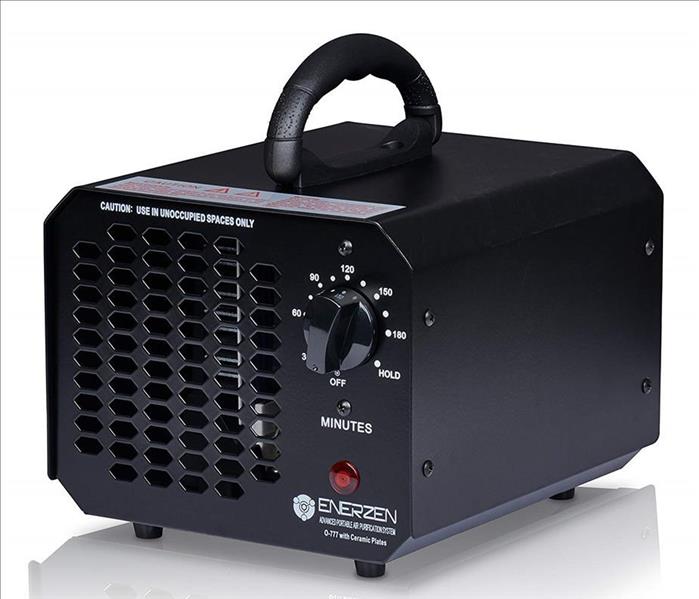 Ozone Machine
Ozone Machine
The busiest part of the house is the kitchen and it can also be the most dangerous. Fire in the kitchen can be disastrous. Most of, if not all or your kitchen items will still have the lingering smell for a significant time after the fire. When the affected area is not cleaned correctly it may become permanent. SERVPRO of Santa Rosa County does not recommend you attempt to clean fire damage yourself. Go through the proper channels to ensure everything is taken care of by professionals. After our technicians assess what has happened, there are a few steps SERVPRO of Santa Rosa County can take if your home suffers fire damage.
SERVPRO of Santa Rosa County can use our "ozone machines" for such jobs.
"Ozone machines" work by creating ozone (o3) via an electrical charge. Ozone is very unstable: o3 wanting to become o2. That third oxygen molecule is looking for something else to bond with. It bonds very well with the smoke, distorting the smoke molecule and neutralizing the smoke odor.
SERVPRO of Santa Rosa County will plug the ozone machine into the wall, set the timer (12-24 hours depending on the extent of the smoke damage) and let it do its thing in your home. After the timer is up you need to let the ozone break down completely into regular o2. (I recommend a full 24 hours). The house will smell a little weird, kinda bleach-like. But that fades completely as the ozone breaks down. Ozone half life is less than half an hour, so giving a full 24 hours will ensure that everything is back to normal inside.
IMPORTANT: The only hard part about all this is that NOTHING alive may be in the house while you are ozoning. It is very, very harmful to breath the stuff in. No people, no plants, no pets... you have to clear everything alive out. Pack up the family and move in with a friend or into a hotel for about two days (one to ozone, one to clear the air of ozone). Once the o3 breaks down into o2 there is no harm.
What to do and not do after a fire.
10/7/2019 (Permalink)
After any fire damage situation, your primary focus should be safety first:
- Is it safe to stay in the house?
- Electrical and "slip and fall" hazards are some of the most prevalent concerns.
- Only do activities that are safe for you to perform.
- Wet materials can be VERY heavy. Be careful!
Have Smoke or Fire Damage? Call (850) 939-4700
What To Do After A Fire
- Limit movement in the home to prevent soot particles from being embedded into upholstery and carpets.
- Keep hands clean so as not to further soil upholstery, walls and woodwork.
- Place clean towels or old linens on rugs, upholstery and carpet traffic areas.
- If electricity is off, empty freezer and refrigerator and prop doors open.
- Clean and protect chrome with light coating of petroleum jelly or oil.
- Wash houseplants on both sides of leaves.
- Change HVAC filter.
- Tape double layers of cheesecloth over air registers.
What NOT To Do After A Fire
- Don't attempt to wash any walls or painted surfaces or shampoo carpet or upholstery without contacting us.
- Don't attempt to clean any electrical appliances that may have been close to fire, heat or water without consulting an authorized repair service.
- Don't use any canned or packaged food or beverages that may have been stored near the fire, heat or water.
- Don't turn on ceiling fixtures if ceiling is wet. The wiring may be damaged.
- Don't send garments to an ordinary dry cleaner. Improper cleaning may set smoke odor.
Why Choose SERVPRO of Santa Rosa County?
12/19/2016 (Permalink)
Fire Damage Repair and Restoration
In addition to fire, smoke, and soot damage, your Pace, Milton, Navarre or Gulf Breeze home may also suffer from water damage as a result of the firefighting efforts. This type of damage can be especially upsetting and destructive for your family to process. You may feel stressed, confused, and vulnerable, so you’ll need a caring expert to guide you through this crisis. We’ll treat you with respect and empathy, and we’ll always treat your home and belongings with care.
SERVPRO of Santa Rosa County specializes in fire and water damage restoration. We have the specific damage restoration training, personnel, and equipment and can quickly restore your home to pre-fire condition.
Need Smoke or Fire Damage Cleanup Services?
Call Us Today – (850) 939-4700
Why Choose SERVPRO of Santa Rosa County?
We’re Faster to Any Size Disaster
Immediate action is crucial when dealing with water and fire damage. We’re dedicated to responding immediately when you need help. A fast response helps lessen the damage, limits secondary damage, and reduces cost.
We’re Fire and Water Damage Specialists
We specialize in fire and water restoration. We’ve received advance training in restoration techniques, and we have the experience and specialized equipment to quickly restore your property.
- Fire & Smoke Restoration Technician
- Odor Control Technician
- Upholstery & Fabric Cleaning Technician
- Water Damage Restoration Technician
Our Restore vs. Replace Mentality
We focus on restoring versus replacing because restoring the affected areas of your property is substantially less costly than demolishing and replacing those areas. This “restore first” mentality also allows us to get your home or business back to pre-fire condition quicker and with less disruption.
Locally Owned Company for over 20 years.
SERVPRO of Santa Rosa County is locally owned and operated, so we are part of this community too. When you have a smoke or fire damage emergency, we’re already nearby and ready to help. We take pride in being a part of the Milton, Pace, Navarre & Gulf Breeze communities and want to do our part in making it the best it can be.
Our Fire Damage Restoration Services
Since each smoke and fire damage situation is a little different, each one requires a unique solution tailored for the specific conditions. When various materials burn, the soot and residue they create differs greatly and requires a specific cleaning procedure. The steps listed below illustrate our process for the “typical” fire damage restoration.
- Emergency Contact
- Inspection and Fire Damage Assessment
- Immediate Board-Up and Roof Tarp Service (if needed)
- Water Removal and Drying (if water damage is present)
- Removal of Smoke and Soot from All Surfaces
- Cleaning and Repair
- Restoration
Have Questions about Fire, Smoke, or Soot Damage?
Call Us Today – (850) 939-4700
Fire Damage Requires The Right Equipment For Remediation.
10/22/2016 (Permalink)
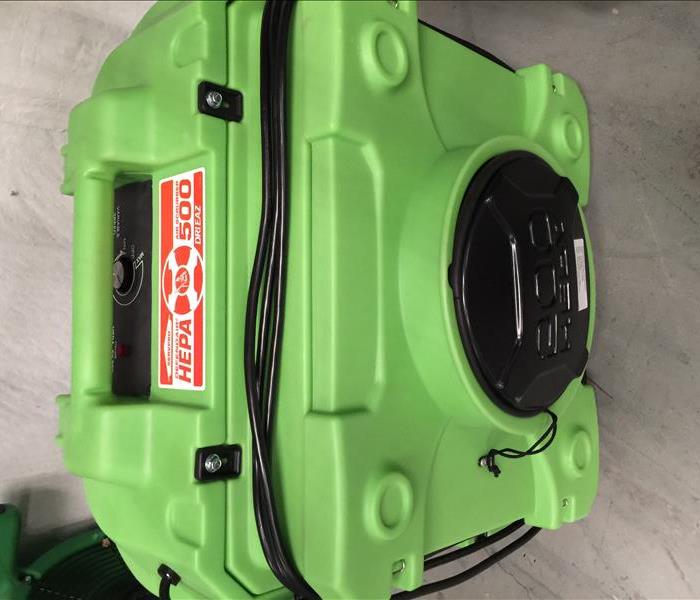 When It Comes To Fire Damage Equipment Matters.
When It Comes To Fire Damage Equipment Matters.
SERVPRO of Santa Rosa County has the Training And Experience.
Having the right Equipment and Training is crucial in the Restoration Industry.
Air Scrubbers are one of many different types of equipment used in restoring your home or business after o loss.
An air scrubber is a portable filtration system that removes particles, gasses, and/or chemicals from the air within a given area. These machines draw air in from the surrounding environment and pass it through a series of filters to remove contaminants. Used frequently for Mold & fire Damage jobs.
Santa Rosa County Smoke and Soot Cleanup
10/22/2016 (Permalink)
Smoke and soot is very invasive and can penetrate various cavities within your home, causing hidden damage and odor. Our smoke damage expertise and experience allows us to inspect and accurately assess the extent of the damage to develop a comprehensive plan of action.
Smoke and soot facts:
Hot smoke migrates to cooler areas and upper levels of a structure.
Smoke flows around plumbing systems, seeping through the holes used by pipes to go from floor to floor.
The type of smoke may greatly affect the restoration process.
Different Types of Smoke
There are two different types of smoke–wet and dry. As a result, there are different types of soot residue after a fire. Before restoration begins, SERVPRO of Santa Rosa County will test the soot to determine which type of smoke damage occurred. The cleaning procedures will then be based on the information identified during pretesting. Here is some additional information:
Wet Smoke – Plastic and Rubber
Low heat, smoldering, pungent odor, sticky, smeary. Smoke webs are more difficult to clean.
Dry Smoke – Paper and Wood
Fast burning, high temperatures, heat rises therefore smoke rises.
Protein Fire Residue – Produced by evaporation of material rather than from a fire
Virtually invisible, discolors paints and varnishes, extreme pungent odor.
Our Fire Damage Restoration Services
Since each smoke and fire damage situation is a little different, each one requires a unique solution tailored for the specific conditions. We have the equipment, expertise, and experience to restore your fire and smoke damage. We will also treat your family with empathy and respect and your property with care.
Have Questions about Fire, Smoke, or Soot Damage?
Call Us Today- 850-939-4700
Vandalism Fire
8/23/2016 (Permalink)
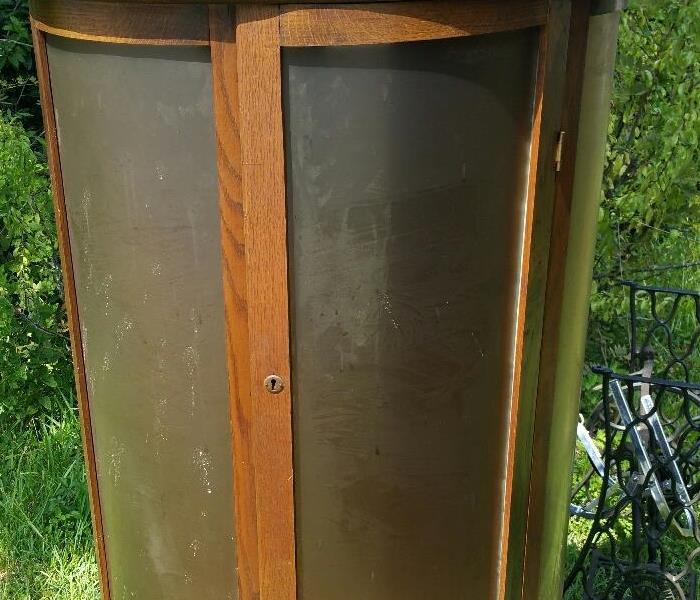 Smoke damage
Smoke damage
Fire caused by Vandalism causing smoke and soot damage to all the contents.
SERVPRO of Santa Rosa County was called into to pack and remove all contents.
The renter's insurance company requested salvageable contents be cleaned by SERVPRO of Santa Rosa County with our "state of the art" ultrasonic cleaning system.

 24/7 Emergency Service
24/7 Emergency Service




